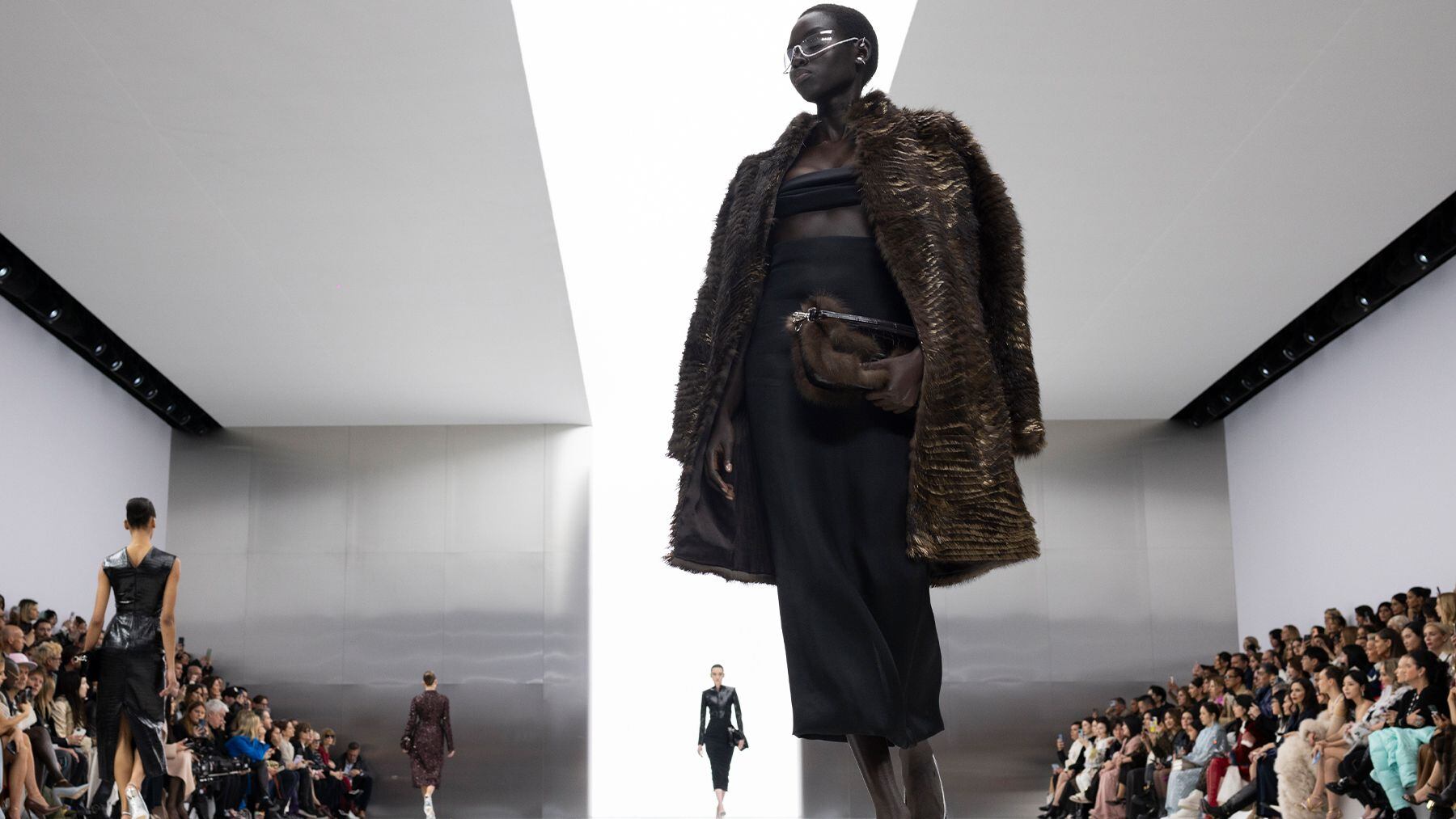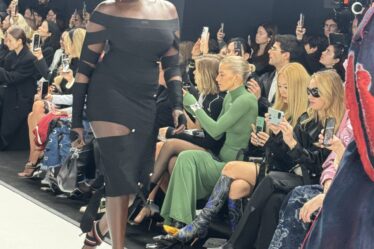
PARIS — A wind of aesthetic restoration is currently hitting the fashion system. The clear message from the haute couture week that closed on Thursday night in Paris was the return of dressmaking, whichmostly made for clothes that were wearable, if a little boring. This wasn’t a season of dreams. It was about opulent realism.
A certain straightforwardness has always been important to Dior designer Maria Grazia Chiuri, whose take on the house’s lexicon is at once pragmatic and sensitive, direct and fuss free. Her work, which relies quite heavily on Dior’s archive, lacks the thrill of the new, despite her endless artist collaborations — this time the set featured giant silhouettes of Ottoman dresses, devised by Isabella Ducrot — and heartfelt feminist messages. And yet the clothes are always very flattering: a woman talking to women, which helps to explain Dior’s big success.
In recent seasons, her couture offering has been simple but impeccably rendered and the latest outing was the same, inflected with a 1950s feel, complete with full skirts, nipped waists and spherical kitten heels, and interesting juxtapositions of utilitarian cottons and regal moiré silks. Memorable it was not. But it was honest.
Over at Chanel, Virginie Viard is another woman designer talking to women, albeit in ways that are not always easy to decipher. The queues outside Chanel stores speak to the enduring clarity and desirability of the brand. But Viard’s collections often point in many different directions at once. This season it was everything from ruffs to tweed, from short and svelte to draped. The link was her stress on the lightness and translucency of tulle, but the results looked more flimsy than grand.
Say the word tulle and Giambattista Valli immediately comes to mind. His familiar gowns made from metres and metres of the material were again part of the mix this season, but even Valli was feeling slightly stricter. He explored the pencil-thin, graphic side of his own personality, rendering his vision of femininity — blooming and delicate, but also sensual and fierce — in a fresh way.
There was a giddy kind of freshness at Armani Privé, where Giorgio Armani went against the aesthetic tide with a bolt of playfulness. His never ending show could have done with a tighter edit, but the offering burst with sparkle, colour and a collage of very Armani-esque exotic references. It wasn’t for everyone, but one thing is undeniable: on the verge of turning ninety at the helm of a company fast approaching fifty, Mr Armani still has the drive, stamina and courage to chart new waters.
On paper, Simone Rocha and Jean Paul Gaultier made for strange bedfellows, but in reality, the results of Rocha’s guest designership at Gaultier Paris were a joy to behold, offering real emotion in an otherwise rather unemotional season. The pairing of ruffly infantilism and glamorous seduction worked because by accepting otherness into her own code, Rocha opened up to a lot more possibilities and shades of femininity than she usually does.
There was a stream of romanticism running through the collection, but it was dark, sultry, intoxicating even — thorn-shaped breast cups, anyone? — and a offered a sense of exploration of the infinite complexities of womanhood, from innocence to seduction. The results were touching, amplified by a cast of women of different ages and shapes (a rarity in the age of Ozempic) and a superb score by Frederic Sanchez.
Robert Wun was equally romantic and dangerous, in a much kinkier kind of way. Give or take one or two Viktor & Rolf references, this gruellingly slow show was a feat of intricate pleating, more intricate corseting and stains turned into embroideries.
Pierpaolo Piccioli knows how to stir emotions. Maria Callas singing the aria “Casta Diva” on the soundtrack at a show held in gilded Parisian salons is probably one of the tritest couture clichés of all time, but it was still elating. In top form and reaffirming his status as a master colourist, Piccioli was on a mission to modernise couture by making the shapes streamlined — and at times, in the parkas and cargo pants, sportswear-inspired — while keeping the process true to the ethos of the atelier. There were a lot of Yves Saint Laurent in his 1970s heyday references, and some grand gowns thrown in for good measure, but overall the outing was an assured iteration of Piccioli’s very own mannerism. It was a bit overdone at times, but when he opted for colourful rien the designer truly shone.
Is society’s circus of celebrity and media-entertainment waning? Hardly, but it was interesting to see Schiaparelli’s Daniel Roseberry ditch the outlandish decoration which has made him a darling of the loudest red carpets to focus on structure, keeping the hand as heavy as required and the silhouette bold and in your face. There was a lot of Alexander McQueen in his Givenchy years, but this was also Roseberry’s most assured Schiaparelli outing yet, where the wild surrealism that stems from the brand’s DNA was somehow tamed and made less obvious.
If even eternal pranksters Viktor & Rolf go bourgeois, one just has to sit down and take notice. The duo’s all-black outing was their most conservative in recent times, and even though the little black dresses, gowns, trench coats and tuxedos came, each, in four iterations and progressively elevated levels of scissoring and chaos, they still looked very proper. At Patou, meanwhile, the sense of strictness looked very fresh, in a 1940s kind of way, making for a collection that was as light and as pleasurable as a breeze.
This was ultimately a season of technique over image. That was true at Alaïa, where Pieter Mulier’s latest ready-to-wear offering was all about reduction to virtuoso technique. By now, Alaïa founder Azzedine is a memory. But what remains of his legacy at the house he built is a sense of statuesque femininity and a will to create beauty through dressmaking and the dedication to craft. By working with circular shapes and one single merino wool thread, Mulier achieved a newfound softness that ultimately looked like a reconciliation with the curves of the female body. Not all of it worked — the mille-feuille dresses were a bit clumsy and some of the coiling dresses a bit contrived — but overall this was an assured step forward.
At Fendi, precision was on Kim Jones’ mind, making for a chilly exploration of the merging of structure and decoration. Never mind the flou, figure-hugging draping and ribbed knit pieces, it was the architecture of the dresses that came to the fore. Best were the simplest concoctions: tellingly the box-shaped yet ineffable first and last looks, a hint to a new direction redolent of Roman master Roberto Capucci’s linea scatola.
Leave it to John Galliano at Margiela to blow everything away with a magnificently crazy celebration of the transformative powers of clothing: a way to alter oneself and to alter reality. Truth be told, it was all so deranged Belle Epoque that it felt totally John, not a shadow of Martin Margiela in sight. Everything was infused with an air of pauperism and the beauty of the worn. This was a fashion moment in every respect, from the luscious spectacle to the corset silhouette for all genders to the beautiful freaks gliding by. And the results were divinely decadent, both nostalgic and progressive.



